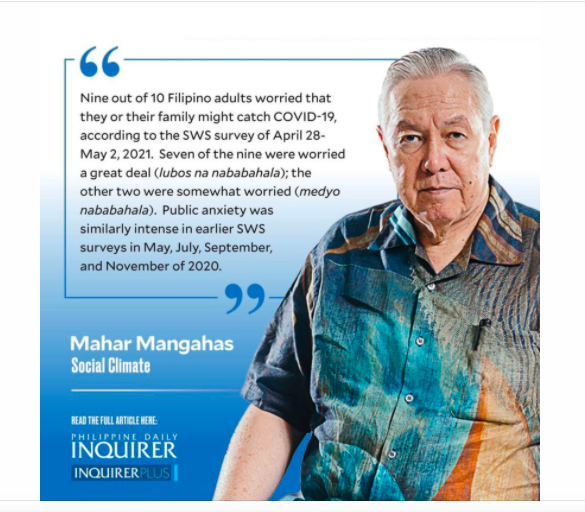Nine out of ten Filipino adults worried that they or their family might catch COVID-19, according to the SWS survey of April 28-May 2, 2021. Seven of the nine were worried a great deal (lubos na nababahala); the other two were somewhat worried (medyo nababahala). Public anxiety was similarly intense in earlier SWS surveys in May, July, September, and November of 2020.
The intensity of Filipino anxiety is very familiar, since SWS probed this on SARS in 2003, Bird Flu in 2004 and 2006, Swine Flu in 2009, and Ebola in 2014. In these surveys, those worried were at least 82 percent, and those worried a great deal were at least 48 percent.
The great anxiety over COVID-19 infection has led the people to endure the drastic restrictions imposed by the government, despite the hardship entailed. I have repeatedly written on this (“Restore jeepneys and tricycles,” 3/21/20; “Allow people the freedom to earn a living,” 4/18/20; “SWS: 4 million got stranded,” 6/13/20; “Catastrophic times,” 8/15/20; and “Surveys of suffering,” 10/10/20). Meanwhile, the Filipino people do understand, and follow, the basic health protocols, trusting that their patience and tenacity will bear fruit.
The rates of known infections and fatalities appear relatively moderate in the Philippines compared to the rest of the world. I like using worldometers.info since it divides its numbers by the country’s population. Its Cases per Million (M) and Deaths per Million are cumulative infections and cumulative deaths over the entire pandemic, of some 14 months now. Then I compute for myself the fatality rate of Deaths per Case. The cases tell us about the infections; the fatalities tell us about the medical care given to those infected.
For the “world” as a whole, consisting of 220 “countries,” as of 6/11/21/9:00 a.m., the case or infection rate is 22,526 per M (i.e. 2.25 percent of all people), while the death rate is 465.9 per M. This implies that 465.9/22,526 = 2.1 percent of the cases have been fatal. These are only the publicly disclosed data; there must be many “dark” cases and deaths as well.
The case or cumulative infection rates are 10.2 percent in the United States, 2.1 percent in India, 2.0 percent in Malaysia, 1.2 percent in the Philippines, and 0.7 percent in Indonesia. Taking the cumulative deaths, and relating them to the cases, gives cumulative fatality rates of 1.8 percent in the US, 1.2 percent in India, 0.5 percent in Malaysia, 1.7 percent in the Philippines, and 2.5 percent in Indonesia.
Worldometers.info now has New Cases per M and New Deaths per M, presumably updated daily. It does not give a world average. The new cases/infections per M are 35 in the US—clearly indicating recovery—66 in India, 67 in the Philippines, 173 in Malaysia, and 32 in Indonesia. The new deaths per M are 1 in the US, 2 in India, 1 in the Philippines, 2 in Malaysia, and 0.8 in Indonesia.
The solution in sight for the pandemic is mass vaccination. Unfortunately, Filipinos are handicapped by a predisposition to mistrust science. Almost half of us have the attitude that “modern science generally does more harm than good,” while only one in five disagree. Filipinos happen to be an exception to the strong global tendency to trust science, according to cross-country surveys.
Despite the overhang of skepticism, and our brand- and country-preferences for vaccines, even the one-third already eager to be jabbed are so many millions of Filipinos that it will be limitations on the vaccine supply, not the demand, that will hinder the early achievement of herd immunity.
——————
For reference, the reports from the First Quarter 2021 Social Weather Survey (www.sws.org.ph) are: “51% of Filipinos are confident, 17% are not confident about the government’s evaluation of COVID-19 vaccines,” 5/20/21; “63% of adult Filipinos prefer the USA as a source of COVID-19 vaccines,” 5/24/21; “79% of adult Filipinos say violators of health protocols are the real cause of the current spread of COVID-19,” 5/28/21; “89% of adult Filipinos are worried about catching COVID-19,” 6/3/21; “Large majorities continue to comply with basic COVID-19 safety protocols,” 6/10/21.
——————
Contact: mahar.mangahas@sws.org.ph
